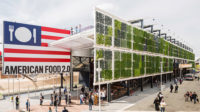Open since May 1, this tightly packed world's fair of architectural hits and misses runs through October 31.
The first world exposition, held in London in 1851, occupied Joseph Paxton's Crystal Palace. But during the last century, expos (also called world's fairs) evolved into collections of national pavilions that competed for attention with novel and grandiose building designs. The Shanghai Expo in 2010 kicked off the “Asian century” with a show of architectural pyrotechnics that reportedly attracted 73 million visitors.
The theme of Expo 2015 in Milan is “feeding the planet: energy for life.” Initially, a master plan by architects Jacques Herzog, Mark Rylander, Ricky Burdett, Stefano Boeri, and William McDonough proposed that each participating country get a “standardized” pavilion, giving them a chance to distinguish themselves with content, not starchitecture. But Expo organizers succumbed to political pressure, and the fair devolved into another architectural bake-off, particularly jarring because the site is relatively small at 490 acres (compared to Shanghai's 1,300 acres). This creates unfortunate adjacencies. The impressive Chinese pavilion designed by Yichen Lu, for example, looks almost ridiculous flanked by a “Zen Express Street Food Corner” and a gaudy Swatch kiosk. Every few hundred yards, there's a large, motel-like building housing restrooms, cafés, and other essentials. Otherwise, the expo is a free-for-all. The problem with abandoning the original master plan isn't that the architecture got wild and woolly, but that the theme—which promised discussion of a vitally important subject, and an opportunity to compare apples to apples—disappeared along with architectural restraint.
Protesters have denounced the expo for a wide range of issues including reported corruption, expense, and what they see as pseudo-environmentalism, given the presence of corporations like McDonald's and Coca-Cola at the Expo. And almost everyone has complained about all the walking. Unlike previous world's fairs, which offered monorails, cable cars, and innovative “people movers,” this expo offers no transportation other than a bus plying a lonely perimeter road. “I know it's a problem; we're going to fix it,” said the CEO of the fair, Giuseppe Sala. (I met him when, exhausted, I decided to hitch-hike, and Sala gave me a lift on his golf cart.)
There were also delays getting the pavilions finished in time for opening day. Pavilion Zero, hugging the main entrance to orient visitors to Expo, was among the unready. It turns out to be the best pavilion by a long shot. Designed by Italian architect Michele de Lucchi as a series of domed buildings, it illustrates key Expo themes. In the first room, de Lucchi built a wooden library that is as heroically scaled as the all-wood Teatro Farnese in Parma. In the succeeding rooms, models, videos, and immersive environments demonstrate the effect of man's search for food on the planet.
Another pavilion that opened late is the Future Food District, a working supermarket with sci-fi touches conceived by Turin-based architect and MIT professor Carlo Ratti. Future grocery shopping may involve “printing” meals, and robots that gather our favorite items, adding personalized cocktails of nutrients, and wrapping the results in edible spray-on packaging. Most of the innovations seem hokey—perhaps the way television seemed at the 1939 New York World's Fair—but at the very least Ratti's clean-lined supermarket promises an architecturally elegant future.






















Post a comment to this article
Report Abusive Comment